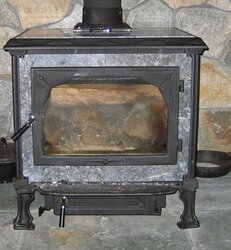I have a Hearthstone Soapstone Mansfield stove. I have it set back 16 inches from the front to meet code on the floor. There is 8 inches to the back wall that is stone set on a masonry chimney. When the stove is running for extended periods the stone can get very warm to almost hot directly behind the stove. It does not go over 212 (assumption) cause you can wipe a rag with water on it and it will dry in 30 to 60 seconds, however no sign of steam.
Should i have any concern. I can buy the heat shield for this stove for minimal cost 80 bucks and keep the heat off the wall. Any suggestions. I did not know if long term this will harm themortar holding the rocks together(from the temp variations). Stove companies never see to mention non combustible clearance.
Should i have any concern. I can buy the heat shield for this stove for minimal cost 80 bucks and keep the heat off the wall. Any suggestions. I did not know if long term this will harm themortar holding the rocks together(from the temp variations). Stove companies never see to mention non combustible clearance.



